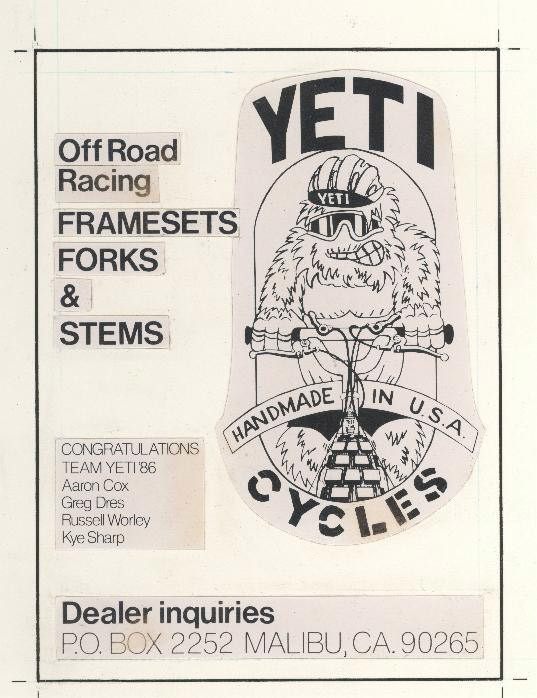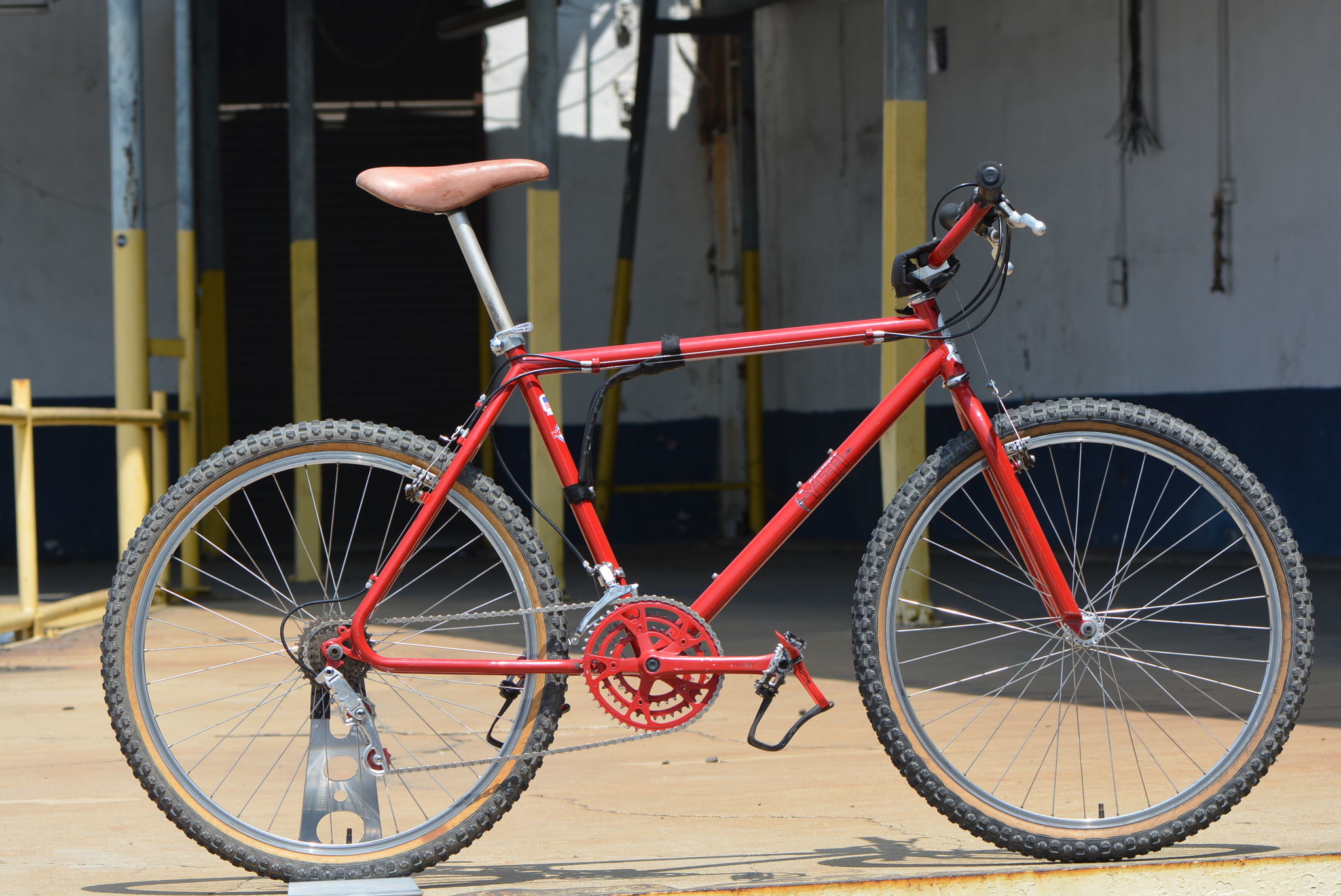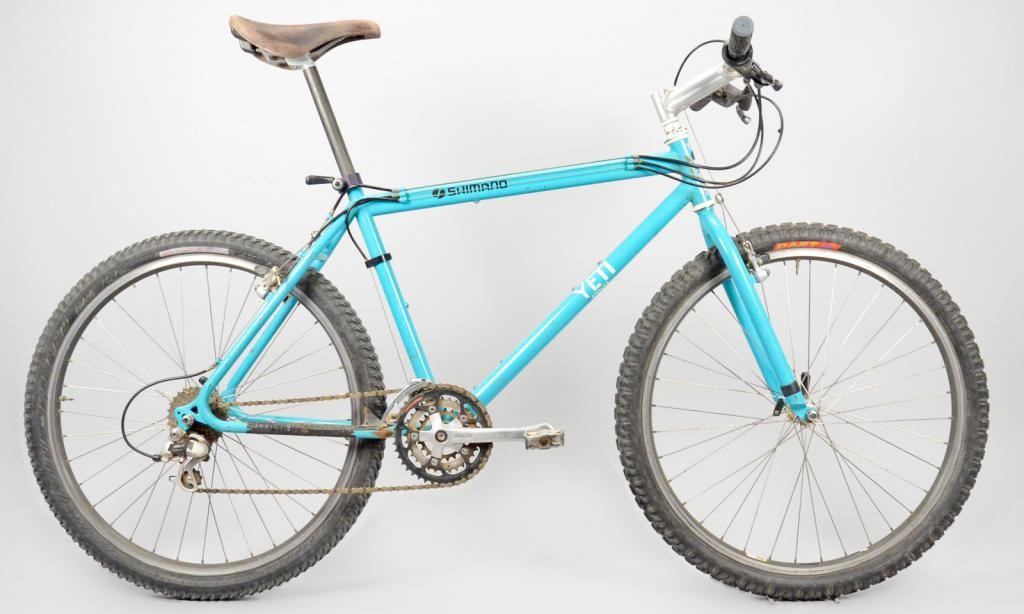Yeti history – 1985 & 86 Early California years
Early Yeti History: 1985 First production run
According to John Parker, upon taking over the reigns of Sweetheart cycles and beginning what would become Yeti he fabricated three bikes. One was built up and sold out of Emily K’s Bicycle Clothing Store in Downtown Santa Barbara Calif (the first Yeti ever sold), another one was built for Russel Worley (as seen in MBA) and one for Linda Parker. He thought he may have built one for himself and maybe one other for Matt Sweeney (where the first Yetis ended up getting made), but those may have been later. Today only one of these bikes is accounted for, the bike that ended up being sold in Ventura. I spoke with the original owner and she confirmed buying the bike in 1985 and sent a few photos of the bike when she owned it. It was sheer luck that she ran into John at a Motorcyle show he was putting on in LA and ended up giving the bike back to him.
Yeti #1
Although this bike was built and sold as a Yeti it’s basically a Motocruiser. JP incorporated many of the modifications he experimented with on Aaron Cox’s and his own Motocruisers (see Motocruiser history) prior to starting Yeti.
These include:
- Top tube routed cable routing (brake and rear derailleur on drive side and front derailleur on the non-drive side)
- Moving away from full length housing in favor of cable stops
- Adding a front derailleur cable stop on the chainstay wishbone
- Shortening the length of the wishbone
- Using a European bottom bracket
- Using a 26.6mm seat post instead of 25.4 BMX style post
- Adding a 2nd water bottle mount on the down tube
According to John, when he took over Sweetheart Cycles he inherited a lot of bad credit left behind in Bicycle Bob’s trail. Among those companies that were trying to collect on Bob’s past due payments were Phil Wood. John wasn’t happy with the oval tubes used by Sweetheart and had his own ideas regarding the profile he wanted to us. However, Phil Wood was unwilling, at first, to make custom tubing for John. It is because of this that the early bikes didn’t have what would become the landmark oval top tubes seen on Yetis for years to come.
Sourcing components was also a challenge. John ended up scrounging through whatever parts bins he could get his hands on to build this bike. The drivetrains is comprised of Campagnolo front and rear derailleurs, Simplex shifters with Shimano FC-6206 triple cranks running a Shimano Freewheel on Bullseye wheels. The cranks were loaned to John for testing and fearing that Shimano would ask for them back he painted them red to match the frame.
Originally this bike had a black and white ice axe decal on the down tube and a first generation Yetiman on the head tube. The original owner removed the stickers hoping that it would help prevent the bike from getting stolen. Here is a photo of the original down tube decal.

This type of decal was only found on a few very early Yetis and later on made a short lived comeback around 89/90.
The fork is essentially the same as a Yeti fork, the legs are XX OD (vs YY OD on Yeti forks), dropouts are Campagnolo and the steerer is BMX style, just like early Yetis. The one unique thing are the brake bosses which don’t look like anything else I’ve seen on any Yeti. FTW once told me that early on they could not get any brake bosses and ended up buying Dia Compe brakes that came with bosses, used the bosses and threw away the brakes.
One other thing to note is that this bike lacks any serial number.
Russ Worley’s race Yeti
Russ’ early race bike has been lost to history and so these photos are about the only evidence it ever existed. At first glance it looks like a more modern FRO, but upon closer inspection you’ll notice the round top tube, the split cable routing, and the rack mount on the rear Simplex dropouts. It appears that this bike is pretty much the same as Yeti #1.
I measured the wheelbase on #1 and it came out to 41.5 inches, which is exactly the same as reported in MBA. The later FROs measure out at around 43″ so there were some redesigns along the way it seems.
You can see in the 2nd picture that Russ was riding on BMX style bars at one point before (I assume before) switching to the Salsa stem as shown in the July 87 MBA article. According to JP and FTW Yeti had to modify MTB stems to use them on their early bikes due to the BMX sizes steerers they used early on. I’m assuming that the 2nd photo is and earlier depiction of the bike as Russ doesn’t have any of amazing Cook Bros parts which would become the hallmark of the early Yeti racing team.
Unfortunately I can’t find any more pictures of the bikes from the first production run. There are a couple bikes I have come across that share some similarities with the first production run bikes, but it’s hard to say if they were built at the same time or later on.
Matt Sweeney’s FRO?
I have not been able to confirm the true history of this bike. It doesn’t seem to have a serial number, however it may be hidden under two coats of paint (the bike was originally white). It has traits of later bikes and so I am a bit leery of whether this could really be one of those first 3-5 bikes. At one point it was said that this was Linda’s bike, but the size doesn’t match up with that theory as Linda was not very tall. Unlike #1 and Worley’s bike this bike has more traditional cable routing with all stops on the drive side, a trait characteristic of production FROs.
The ‘Team Shrew’ decal was something John gave out to his close friends and is only found on a select few bikes (John’s MC, Worley’s 411 FRO and this bike). The fact that this sticker is here lends credibility to the theory that this was Sweeney’s bike, just not that it was an early bike.
Early Yeti history – 1986 First FROs
Chris Herting and Jim Emerson had a shop in San Fernando (John used to call it a “Mexican watering hole” which was true) and Frank was doing their welding. Both Chris and Frank were in there when John answered an ad in BMX plus and wanted to make bikes. They built our first 20 or so bikes there. We then moved manufacturing to Burbank California and worked in the back of a special effects shop called First Take Production (some machining work was also done at Matt Sweeney’s special effects shop). This arrangement continued for another year or two before moving to Agoura.
According to Frank, prior to the start of Yeti, the top tubes were made from the same Phil Wood material that was used for the chain stay mono tube which was tall and very narrow. It was in San Fernando that we started using the Redline tubes (the well known shape) for the top tube, purchasing a huge pile of them along with Dia-Compe canti bosses (along with the brakes which they tossed LOL). Frank recalled welding more than one round tube frame during that period in between the switch.
Frank figured out a way to put the cable stops all in a row by welding the backs of them together but John had the idea of placing them in a row. Chris rotated the dropouts and improved the frame in many subtle ways when they first started building them. The tooling was rough when they started and it was Chris who did a great job sorting it all out. Frank recalls it was a hoot working for John and with all those guys there!
As mentioned earlier early on Yetis used some tubing sourced from Redline tubes. Included in this were bottom bracket shells, which carried the XR designator (stamped by Champion). Hence the very early FROs (approximately 50 or so) have serial numbers that start with XR. Furthermore, the number sequence started with 300 because John wanted to make it seem like they already made a lot of bikes. According to John, Linda was very engaged in order fulfillment and production and therefore bikes are built in sequential order. So, for the sake of argument we can assume that a bike with a lower serial number predates another bike with a higher serial number.
Yeti FRO XR309
This is the lowest serial number FRO known to be in existence and was most like a team race bike. I don’t know who it may have belonged to, but judging by the size it may have been either Greg Dress or Rob Nielsen.
Features:
- Round top tube
- 2 o’clock cable stop location
- 26.8mm seat post
- BMX head tube
- Machined down stem to fit steerer
- Simplex dropouts
- 1st Generation Yetiman head tube decal
Here is a photo of Rob Nielsen with his Yeti. You just barely make out the shadow left behind by the same COOK BROS RACING sticker on the top tube of my frame.
This FRO features basic Yeti cycles decals on the down tube and a first generation Yetiman on the head tube. There is also a 100% sticker, which was a personal favorite of Johnny O’Mara and he was known to put them all sorts of stuff in the Yeti garage. It also carries a small shark decal identifying it as a frame painted by Land Shark.
FRO XR314
This is another very early example of the FRO and another probable team bike. Yeti had a fair number of racers across several classes at the time and the build on this bike points in the direction of a team kit.
Aside from slightly different cable routing this bike is virtually identical to XR309. Both have first generation Yetiman head tube badges, round top tubes but while this bike appears to have a 26.6mm seat post XR309 is 26.8. This bike is a stunning example of what a properly built, early Yeti team bike should look like. I actually think that this bike, with it’s 26.6mm seat tube and the 3 o’clock cable stop location may have been built before XR309 as those features point towards an earlier build style. Also, it’s possible that FTW did 2 o’clock and CH did 3 o’clock and they were going through left over tubing hence the variety in the early frames. We still see 26.6 seat posts used well into the high 300 serial numbers.
Features
- Round top tube
- 3 o’clock cable stop location
- 26.6mm seat tube
- BMX head tube
- 1st Generation Yetiman headtube badge
- Simplex dropouts
XR315
This is another very nice example of an early FRO that is not a race bike, meaning not all XR numbered FROs were team bikes. This bike is virtually the same as XR309 and XR314 and originally came with a matching fork and stem.
Sadly, I don’t know the owner of this bike so I can’t verify too many details in person.
This is the sister bike to this lovely FRO (link, serial number unknown)
FRO XR 325 – Paul Thorson’s race bike
This is Paul’s actual race bike. The above photo is the only photo of the bike from his days on the team. It has since been repainted and stripped of most of the exciting components. However, the frame, fork and bar/stem remain together.
Features:
- Round top tube
- 3 o’clock cable stop location
- Simplex dropouts
- BMX head tube
- 26.8mm seat post

FRO XR341
This bike appeared rather suddenly on eBay in 2014. The seller claimed that the bike was a team bike was belonged to Johnny O’Mara and was even used by Tomac at one point or another. None of those claims were substantiated and the bike changed hands a few times before settling in Europe. On the surface this seemed to be a regular FRO, however the presence of the Aluminum FTW stem and carbon seat post (similar build to Worley’s 411 FRO) lends some credibility to the theory that this bike was in some way connected to the factory team.
Features:
- Oval top tube
- 2 o’clock cable stop location
- 26.8mm seat post
- BMX head tube
- Simplex dropouts
- FTW alloy stem (probably added later)
Russ Worley’s race bike 411
This is Russ’ 2nd FRO that he raced on during the 1988 and 89 seasons. The bike has lived a hard life after that and is currently undergoing a mild restoration.
Here is one of the only photos of Russ (1989) I could find racing this particular bike. Notice the alloy FTW stem and blue/turquoise anodized bars. Also notice Slomac next to Russ on his Ti Mongoose!
Features
- Oval top tube
- 2 o’clock cable routing
- Simplex dropouts
- 26.8mm seat post
- BMX headtube
I included this particular FRO as it serves as a nice transition point between the early FROs and what we can start calling production FROs. Not that the early bikes were dramatically different and magical, but there were still variations and changes over the first year or so. But, by maybe mid to late 1986 things started settling down and the design remained largely unchanged until about 1989, which I will cover in the next chapter.
Summary/Conclusions:
Based on my small serial number database (30 early bikes spanning first 400 builds) I can draw the following conclusions
- Round top tubes were predominantly used on the first 70-80 FROs (again for a short time around the low 600s)
- Cable stop location moved around a little bit in the early frames before settling down at the 2 o’clock position
- Seat post sizes on the early FROs seemed to vary between 26.6 and 26.8mm, there doesn’t seem to be any pattern, maybe the reaming process wasn’t very consistent
- Very early FROs had custom stems adapted for use with BMX style forks
- A majority of CA build FROs (up to S/N ~800) had Simplex dropouts and BMX headtubes
Completed Projects:
Current Projects:
Newsletter sign up:
Subscribe to our newsletter to receive info on our latest projects and new podcast releases


















